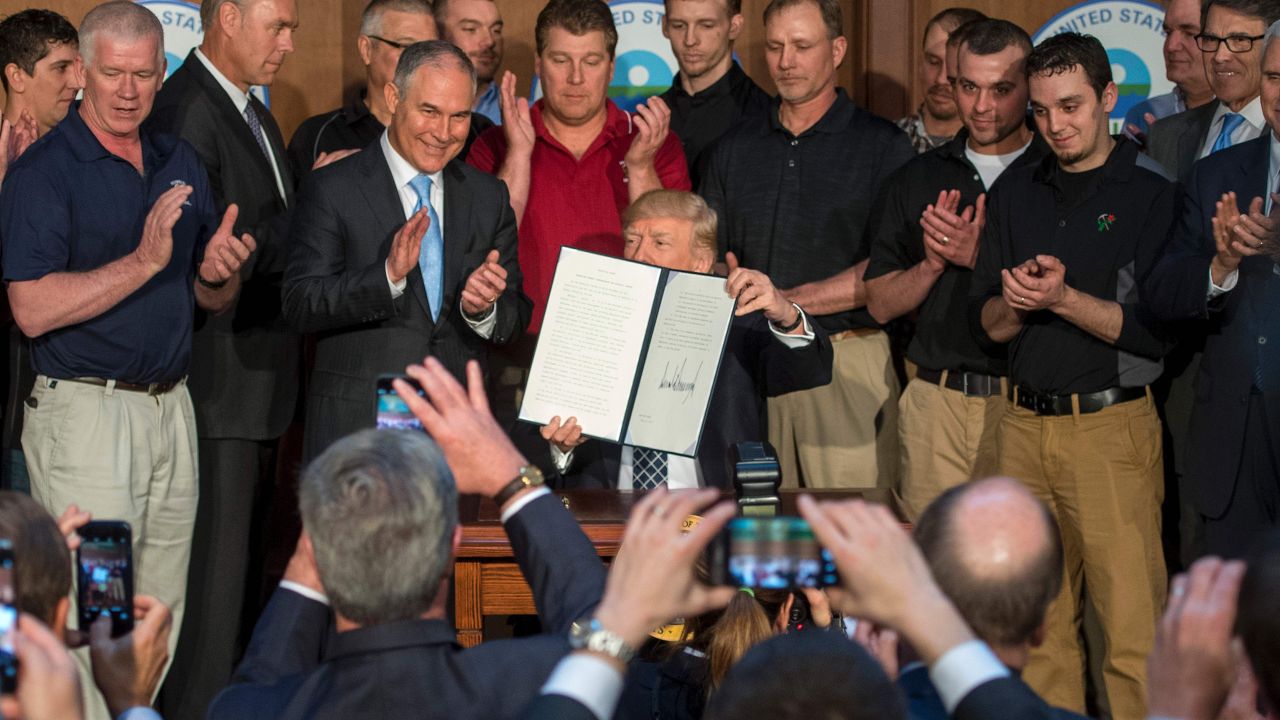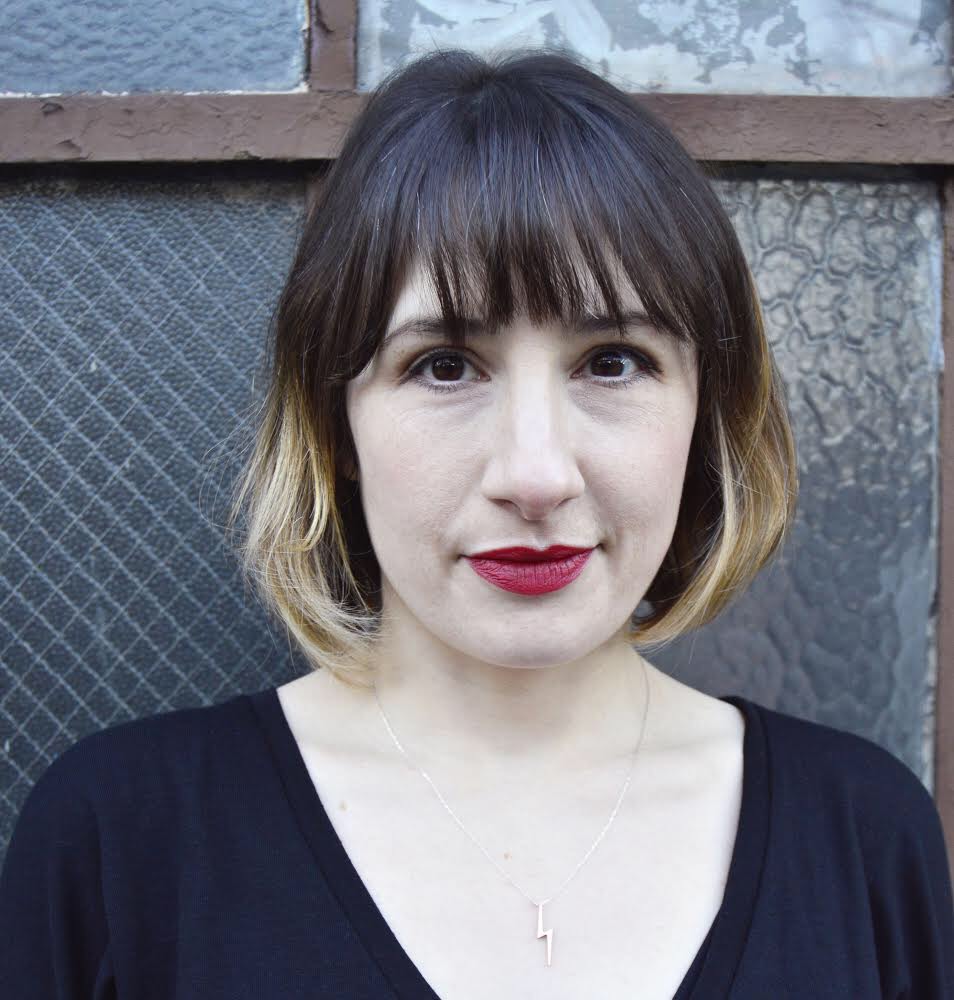
Surrounded by miners from Rosebud Mining, President Donald Trump shows the signed Energy Independence executive order at the Environmental Protection Agency (EPA) headquarters in Washington, DC on March 28, 2017. Trump claimed an end to the "war on coal" as he moved to roll back climate protections enacted by his predecessor, Barack Obama. (Photo by Jim Watson/AFP/Getty Images)
This story is part of Sarah Jaffe’s series Interviews for Resistance, in which she speaks with organizers, troublemakers and thinkers who are doing the hard work of fighting back against America’s corporate and political powers.
Last Thursday, Donald Trump announced his executive order rolling back the climate protections that had been put in place toward the end of Barack Obama’s presidency. Key to that move was eliminating the Clean Power Plan — already a compromise that was far from enough to halt catastrophic warming. Jordan Estevao of People’s Action, a network of community organizations in 30 states, has been organizing around a vision of climate justice that puts the most vulnerable communities at the center of the fight, and he spoke with me about the response to Trump’s cuts. My interview with him has been lightly edited for clarity.
Sarah Jaffe: So, Donald Trump is trying to destroy the planet. Can you tell us what exactly his order today [Tuesday] was repealing?
Jordan Estevao: There are several regulations that he is attempting to overturn with this EO [executive order], but the one that we are most interested in is the Clean Power Plan, which is the United States’ main contribution to the Paris Accords to reduce climate change. Every major emitter, including China, agreed to reduce carbon emissions by a certain amount in order to avoid catastrophe. The United States set a target of 30 percent reduction [Ed: 26 percent to 28 percent] and this was our main way get there. It required every state to reduce its carbon emissions by a certain amount by a certain time. If it doesn’t go into effect, that is a bad thing. That said, even the Clean Power Plan, we only saw it as a good start to getting to where we actually need to go.
SJ: The Clean Power Plan, it also had to be done state by state, correct?
JE: Exactly right, yes. Every state was assigned a certain percentage by which to reduce its emissions. It would range from 5 percent, or actually 0 percent in states like Vermont, to 30-40 percent in some of the higher emitting states where there is more coal-fired power production and so on.
SJ: If it is state by state and there is a federal executive order on this, the states that want to can go ahead and do this anyway, correct?
— Jordan Estevao
JE: That is exactly our approach to this. There are multiple states that had no plans to comply anyway. Actually, since last summer it has kind of been in limbo, the regulation, because as Antonin Scalia’s final act as a Supreme Court Justice, he and the court issued a stay on the order, which has left the states that wanted to keep on complying on track and some states waiting to see what happens. But there is still lots of potential to win good policies. Our Illinois affiliates, Illinois People’s Action and Fair Economy Illinois, just recently passed the Illinois Future Energy Jobs Act, which is going to greatly increase Illinois’ renewable energy production. It is going to invest between $500 and $750 million in low-income communities for energy efficiency, renewable energy, job training, so that low-income people can get into that kind of work, and so on.
I think what a lot of folks on the right and in the Trump administration are missing is that the transition to clean energy, to energy efficiency actually could be a huge economic driver and a way to revitalize our economy, especially since the coal industry is already going under. It is already being undercut by fracking and low oil prices. Coal companies have been going bankrupt at a really high clip with no end in sight. He is not going to bring those jobs back. There is no bringing them back. What we do need to do is figure out where we can invest so that we can start to rebuild an economy that actually puts people to work and also is good for our environment and slows climate change.
SJ: Donald Trump did this with a bunch of coal miners standing behind him — obviously, this is this argument that we are going to bring back these jobs. One of the reasons that I reached out to People’s Action for a comment on this was because your organization’s move into climate justice has been an outgrowth of organizing in low-income communities that certainly understand the need for good jobs. I wonder if you could talk about the way those two things connect.
JE: Absolutely. We are a racial and economic justice organization. We see climate change and the environment as massive economic and racial justice issues. In order to reduce what are already unacceptable levels of pollution, especially in low-income communities and communities of color, in order to slow climate change, to mitigate the effects, to create resilient communities we are going to have to make huge economic and industrial shifts.
We know historically that over and over again, large industrial shifts, for the past 40 to 50 years, have tended to drive inequality. In other words, when the economy expands or a certain sector of the economy expands, it tends to leave certain communities behind. There are tons of examples, but look at the information technology boom and how large swaths of the community have been left behind there. If you go to San Francisco, there are hardly any black people left, because not everybody benefited equally from that industrial growth. Then, you look at the flip side of it, like the housing crash, when the economy contracts, everyone who gets screwed gets screwed, but it is low-income folks and communities of color that get screwed even more. No one lost more equity in the housing crash than black and Latino households, and Asian households for that matter. And there’s no sign of that coming back.
So the economy is shifting; the best that the Trump administration and big oil can hope to do is slow it down. We are going to stop relying on fossil fuels. We are going to have to become more energy efficient. We are going to have to look at renewable energy sources. We are really interested in making sure that those industries are themselves equitable and just and make the kind of choices that would bring up the working class rather than exploiting them.
For example, with the states — Illinois, for example, is going to invest in energy efficiency. Does that mean that it is going to subsidize corporations to build energy-efficient skyscrapers or are we going to invest in the ability for working-class homeowners to weatherize and insulate their homes and install double-paned windows? Are we going to put people from the community to work doing those jobs as a way to both reduce the cost of energy for households who are paying over the odds on their energy and also reduce our carbon emissions and also reduce air pollution?
I saw an article recently about a company that wants to make Trump’s border wall beautiful and sustainable and energy efficient. I think that is just such a golden example of what we are trying to avoid, which is we have sustainable green industries that are still exploitative and drive inequality.
SJ: Also, looking at an article open on my desktop on my computer right now, the headline is “Exxon Urges Trump to Keep US in Paris Climate Accord.” Now, obviously, Trump’s secretary of state is the former head of ExxonMobil. I am wondering if you are following all of these potential splits in this administration and what the sort of levers might be for pushing within the administration, if there are any?
JE: Our contention is that the way to the push the administration is from the bottom up. In other words, to build a bulwark of political will in cities and states, a bulwark of resistance so that regardless of what the federal government does, states are invested in building a clean energy future. That is really where we want to focus. Trump is going to do his bull-in-a-china-shop thing and make a big mess, but we think that if we are going to be resilient against those kinds of attacks, then it is going to come from the grass roots, from local communities and from states.
SJ: You mentioned Illinois, but where are some other states or cities where there is movement on legislation around this at the moment?
JE: The state of Maryland just passed a statewide ban on fracking. It is the first statewide legislative ban on fracking that is in a state where there are proven fracking reserves. It is just more evidence that states are making their own agendas and still have lots of latitude to regulate and legislate around climate and the environment.
SJ: What would you advise for people who want to get involved in this issue who haven’t done so before?
JE: People’s Action and People’s Action-affiliated organizations in 30 states, we are moving from protest to power and from resistance to revolution. We really think that it is important and it is necessary to resist the Trump agenda, to protest the Trump agenda, but we shouldn’t stop there. We shouldn’t get hung up on it or obsessed with federal regulation and legislation. There is tons of work to be done in cities and states. That is where we are going to build the bottom-up infrastructure to really shift the political wind in this country.
Our affiliates are recruiting candidates for office, they are talking to candidates about their agendas and looking for candidates to support an agenda that puts people and [the] planet above corporate profits. This is going on all across the country. Loads of organizations to get involved in. We are training folks not just to run for office, but also how to be an effective volunteer in a campaign, how to run a local legislative campaign, whether it is for a school board or for a rural electric cooperative or for mayor or for state government. There is no shortage of work to be done and we really think that cities and states should be the big priority for how we not just beat back and resist the worst of Trump’s policy agenda, but also how we actually build the political power to shift the country back to a more sane course.
SJ: How can people keep up with you and People’s Action?
JE: You can follow us at @PplsAction on Twitter and also @PplsActionInst.
Interviews for Resistance is a project of Sarah Jaffe, with assistance from Laura Feuillebois and support from the Nation Institute. It is also available as a podcast on iTunes. Not to be reprinted without permission.




